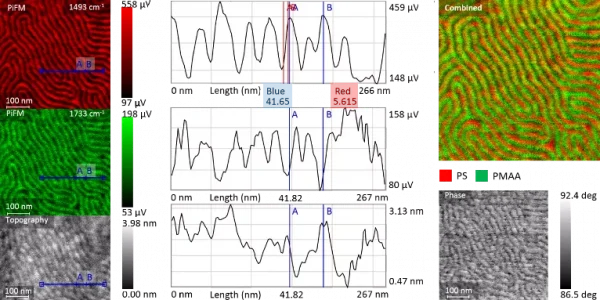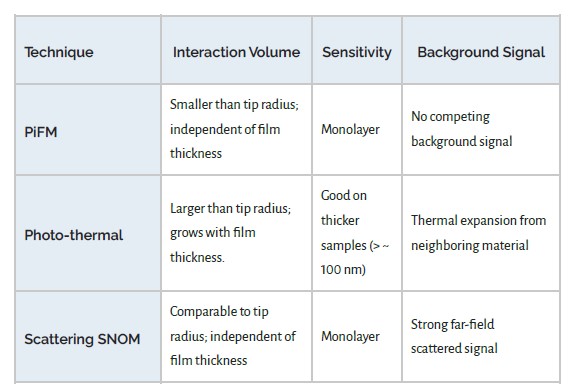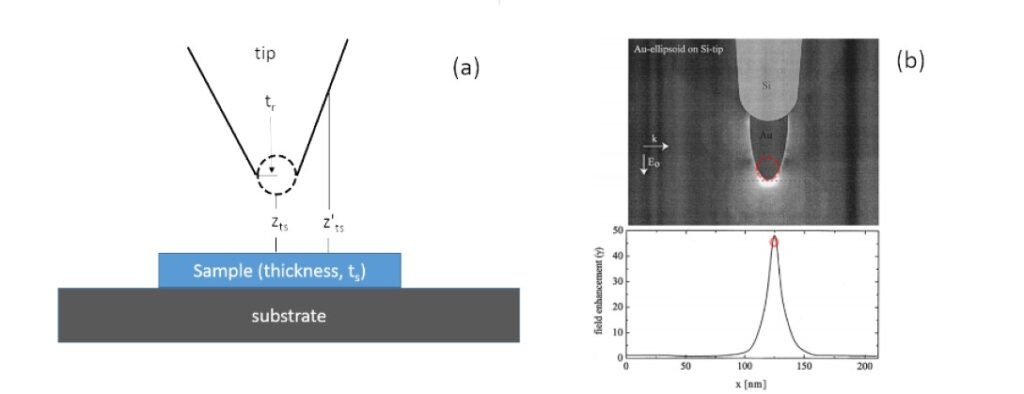
PiFM achieves excellent spatial resolution. Since our Science Advances paper [1], we have enhanced the spatial resolution of PiFM to the point where we are now able to resolve the different chemical blocks of a PS-b-PMMA sample with a pitch of about 22 nm. Figure 1 shows the PS and PMMA molecules in red and green colors, respectively. Cross-sections of the PiFM images for PS and PMMA anti-correlate with each other as they should and show the measured pitch to be about 21 nm (in the cross-section, two pitches are measured). Each polymer molecular block with width of about 11 nm is imaged clearly, and the 10% – 90% rise of the signal measures 5.6 nm, which is used by many as the instrument’s spatial resolution.
The spatial resolution of AFM IR instrument is determined by several criteria: (1) effective volumes of the tip and sample that are interacting; (2) sensitivity of the detection technique; and (3) background signal that will determine the signal-to-noise. Table 1 shows how PiFM compares with the competing techniques in these areas. As can be seen, compared to alternative AFM IR techniques, PiFM enjoys favorable operating conditions on all criteria, which provides the basis for its superior performance, both in spatial resolution and surface sensitivity.

Table 1: A comparison of the three most popular nano-IR microscopy techniques available
Generally, the effective volumes of the tip and sample that are interacting in a scanning probe microscopy technique will depend on the following parameters (see Figure 2): tip radius, tr; the gap spacing between the tip and the sample, zts; and the tip-sample interaction as a function of zts, fi(zts).
These parameters along with the field enhancements that result from the shape and metal coating of the tip and the nature of substrate will determine the lower limit of the spatial resolution. In the special case where fi(zts) is a step function, i.e., the tip-sample interaction is zero until it comes into contact with the sample surface as in PTIR, the sample volume will mostly determine the spatial resolution.
In PiFM, where the photo-induced attractive force determines the spatial resolution, the governing fi(zts) varies with 1/zts4 (or 1/zts2 depending on the nature of the force [2]) so that its magnitude falls off extremely fast with increasing zts. The consequence of the fast fall-off is that, referring to figure 2, fi(z’ts) will be much smaller than fi(zts), thus keeping the interaction volume of tip and sample to be quite small (on the order of the tip radius). It is also easy to see from the geometry that it is important to keep zts as small as possible to keep the ratio between zts and z’ts as large as possible since that will determine the ratio between fi(zts) and fi(z’ts).
In order to achieve the smallest practical zts (~1 nm), the photo-induced force (PiF) is measured by maintaining a constant and small (~1 nm) gap between the AFM tip and the sample surface by feedbacking on the 2nd mechanical mode of the cantilever (whose force constant is ~1000 N/m and prevents snap-in) while modulating the excitation laser at a frequency such that the resulting modulated PiF drives the 1st mechanical mode of the AFM cantilever.
The metal coated tips used for PiFM have a tip radius of 20 – 30 nm while PiFM achieves a practical spatial resolution of ~5 nm. This enhanced spatial resolution arises from the fact that the tip-enhanced field profile is much smaller than the physical tip profile. Figure 2b compares the profiles of the physical tip (upper image) and the tip-enhanced field profile (lower image); two red circles highlight the two different effective “tip radius”, which would determine the spatial resolution [from J. Appl. Phys. 89, 5774 (2001)].

Figure 2: (a) Definition of parameters that determine the spatial resolution of PiFM; and (b) field enhancement creates a smaller effective radius (shown below) for PiFM compared to the physical radius of the gold particle (shown above)
Learn More?
Please click on ‘Request Application Note’ and download the full application note ‘Spatial Resolution of PiFM’.
